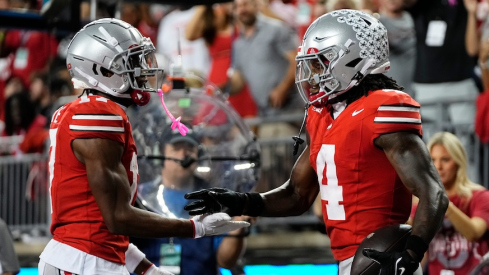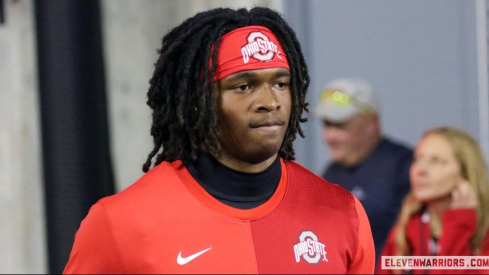
The Ohio State offense continued to click on all cylinders in quickly putting away Purdue Saturday.
The Buckeyes threw early and often in the game's first half, taking advantage of Purdue's 3-3-5 defense.
In so doing, Ohio State used the game as a glorified passing scrimmage, but also as a way to put a marker on film for future opponents who hope to devote additional defenders against the Buckeye run game.
The Buckeye game plan continues to show lessons learned from earlier this season, as Urban Meyer and Tom Herman are making better use of play action early in games to first hit the horizontal flats and then get the football downfield. The result was a career game for Jeff Heuerman, as well as another extremely efficient performance for Braxton Miller.
Below I look at the Buckeyes' road map against opposing defenses, the cohesiveness of the Buckeye offense, and how it sets up Ohio State moving forward.
Throwing to set up the run
Purdue operated from a 3-3-5, two high safety defense. The goal of the 3-3-5 is use the two hybrid outside linebackers/safeties cheat inside against the run and to keep the offense confused in the zone read game.

In the back end the Boilermakers primarily employed cover 2 or cover 3 zone.
In response, the Buckeye offense used the same formula they have successfully utilized since the second half against Northwestern, namely taking advantage through the air of defenses that are devoting additional defenders to the run game. Specifically, the Buckeyes used play action to throw early, first by hitting wide receiver screens and flat routes, and then throwing the football vertically.
Once defenses are forced to honor the passing game then the Buckeyes run the football downhill. In other words, the Buckeyes open with the constraint plays before turning to their base package.
Faking
The game plan has been so effective because the play calling is functioning as a cohesive whole. Against Northwestern the Ohio State offense sputtered at times in the first half, as Ohio State sought to force the football down field off drop back passing against a defense focused on not getting beat deep.
Since that half Urban Meyer and Tom Herman have done a far better job attacking underneath against defenders with run responsibilities. It begins with play action off the inside run game. The Buckeye coaching staff does a nice job making their plays look alike, forcing a defense to respect the run.
Here, the Buckeyes run a bootleg flat route off inside zone slice. Inside zone slice is inside zone from the pistol with the tight end blocking back across the formation. On the same series the Buckeyes already given to Carlos Hyde on the play for a ten yard gain.

The Buckeyes then fake the exact same play, with Nick Vannett slipping out into the flat for a touchdown.

Relatedly, the Buckeyes use packaged plays to stretch the defense. This is the ultimate in making plays look alike, because the offensive line and running back are executing the base run play. It is up to Miller to give or pull the ball and throw. This is most often used with wide receiver screens, but the Buckeyes will also use with a quick hitch route.
Purdue's zone defenders could not account for the Ohio State run game, wide receivers down field, and horizontal throws. The Buckeyes repeatedly created open receivers with a basic curl/flat combination, leading to easy catches for Jeff Heuerman and Ezekial Elliot, among others.

From there, the Buckeyes can fake quick hitting routes to open opportunities down field. Here, the Buckeyes fake a flash screen to throw a switch route.
The Buckeyes particularly like faking such plays with Dontre Wilson in the flat.
The Buckeye offense is thus forcing a defense to defend the field both horizontally and vertically. But the key is that everything is built upon the Buckeyes' prolific inside run game. As the great Homer Smith said
Every primary backfield action needs to threaten all 11 defenders. What a primary play needs is good counter plays. Every defender needs to be worried about the ball coming to his area – on a throwback screen, a reverse, a play-action pass, or whatever – as a play begins.
Trigger Man
The Buckeyes are able to operate such a multi-faceted offense because Miller's decision-making is much improved. He is consistently making solid decisions in the read game in determining when to give, keep, or throw on packaged plays. He is also far more decisive in his progressions in throwing the football, moving through his reads and often making the correct decision when to move and when to escape the pocket.
For instance, Miller did an excellent job going through his progressions on his first touchdown throw to Jeff Heuerman. Miller faked the zone run and then turned to throw the fake bubble screen vertical route. But Devin Smith got knocked off course. Miller then reset and turned to the other side of the field. There, the Buckeyes were running a post corner combination. This provided a horizontal two on one stretch on Purdue's cover 2 safety.

Purdue's safety played the post route, leaving Heuerman wide open to the corner.

Here it is in action.

Earlier in his career, Miller could not consistently operate the offense at this level. Defenses could thus overplay Miller and the Ohio State run game without the same consequences. Even with a defense focused upon Miller and Hyde, Meyer and Herman felt more comfortable running the football than relying upon the passing game or consistently using constraints such as wide receiver screens. It also helps that the wide receiving corps is far more effective both as runners and blockers.
Now, however, Ohio State is able to run a cohesive offense without even relying upon Miller as a runner. He only kept once against Purdue, namely on an inverted veer play that resulted in a first down. Miller's legs now provide the Buckeyes an edge in games where his running is needed, rather than being the primary engine for the Ohio State offense.
Setting a Marker
The Buckeyes' pass happy game plan had an additional purpose. It was a message to future opponents that if they want to focus upon the Buckeye run game Ohio State will look to exploit the resulting holes.
Defenses are thus put in a bind. An opponent must account for the Buckeyes' run game. That is the strength of Ohio State and the effectiveness of that run game is what makes everything work. Defenses must also account for Miller as a runner, even if he runs less frequently, because he remains the Buckeyes' biggest threat.
But a defense must also try and defend the Ohio State passing game, both underneath and down the field. The inability to do all those tasks explains why the Ohio State offense has been so good, scoring the most first quarter points in college football. The hope of Meyer and Herman is that, by throwing the football so often against Purdue, it forces future opponents to prepare to play the pass early in the assumption that Ohio State will throw to begin games. Meyer and Herman's hope is that the result is defenses defending the Buckeyes offense more honestly, allowing Ohio State to run the football even more efficiently.

